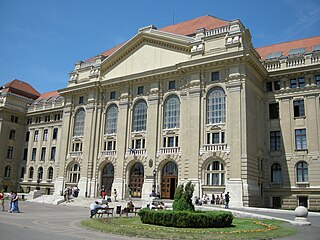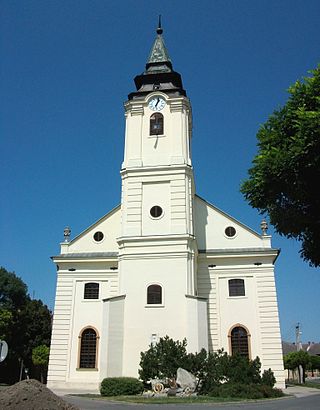
Debrecen is Hungary's second-largest city, after Budapest, the regional centre of the Northern Great Plain region and the seat of Hajdú-Bihar County. A city with county rights, it was the largest Hungarian city in the 18th century and it is one of the Hungarian people's most important cultural centres. Debrecen was also the capital city of Hungary during the revolution in 1848–1849. During the revolution, the dethronement of the Habsburg dynasty was declared in the Reformed Great Church. The city also served as the capital of Hungary by the end of World War II in 1944–1945. It is home to the University of Debrecen.

Eötvös Loránd University is a Hungarian public research university based in Budapest. Founded in 1635, ELTE is one of the largest and most prestigious public higher education institutions in Hungary. The 28,000 students at ELTE are organized into nine faculties, and into research institutes located throughout Budapest and on the scenic banks of the Danube. ELTE is affiliated with 5 Nobel laureates, as well as winners of the Wolf Prize, Fulkerson Prize and Abel Prize, the latest of which was Abel Prize winner László Lovász in 2021.

Józsefváros is the 8th district of Budapest, Hungary. It is the part of the city centre in the wider sense as one of the 18–19th century older suburbs, close to Belváros.

Debrecen International Airport is the international airport of Debrecen in the Hajdú-Bihar County of Hungary. It is the second largest airport in Hungary, after Budapest and ahead of Hévíz–Balaton. Debrecen is the second largest city in Hungary, after Budapest and ahead of Szeged. DEB is located 5 km (3.1 mi) south southwest of the city center and also easily accessible to adjacent regions of Romania and Ukraine.

István Fekete was a Hungarian writer. He wrote several youth novels and animal stories.

The University of Debrecen is a university located in Debrecen, Hungary. It is the oldest continuously operating institution of higher education in Hungary ever since its establishment in 1538. The university has a well established programme in the English language for international students, particularly in the Medical and Engineering field, which first established education in English in 1886. There are nearly 6000 international students studying at the university.

Szarvas is a town in Békés County, Hungary.
The Nemzeti Bajnokság, also known as NB I, is the top flight of Hungarian football league system. The league is officially named OTP Bank Liga after its title sponsor, OTP Bank.

Central Hungary is one of the seven statistical regions in Hungary. It includes Budapest and Pest County.

The 'dwarf' elm cultivar Ulmus 'Jacqueline Hillier' ('JH') is an elm of uncertain origin. It was cloned from a specimen found in a private garden in Selly Park, Birmingham, England, in 1966. The garden's owner told Hillier that it might have been introduced from outside the country by a relative. Hillier at first conjectured U. minor, as did Heybroek (2009). Identical-looking elm cultivars in Russia are labelled forms of Siberian Elm, Ulmus pumila, which is known to produce 'JH'-type long shoots. Melville considered 'JH' a hybrid cultivar from the 'Elegantissima' group of Ulmus × hollandica. Uncertainty about its parentage has led most nurserymen to list the tree simply as Ulmus 'Jacqueline Hillier'. 'JH' is not known to produce flowers and samarae, or root suckers.

Kám is a defunct village 69 kilometres (43 mi) west of Budapest in Vas county, Hungary. Jeli Arboretum is 3.7 kilometres (2.3 mi) away.

Debreceni Vasutas Sport Club is a Hungarian professional football club based in Debrecen that competes in the Nemzeti Bajnokság I, the first tier of Hungarian football. They are best known internationally for reaching the group stages of the UEFA Champions League in the 2009–10 season. Debrecen have become the most successful club in Hungary since 2000, winning the Hungarian League seven times.

István Nagy is a Hungarian agricultural engineer and politician who has served as the Minister of Agriculture in Hungary since 2018.

Vácrátót Botanical Garden is a botanical garden in Hungary maintained by the Hungarian Academy of Sciences. It is located in Vácrátót, some 30 kilometers north of Budapest. The institution is participating in a QRpedia project with Wikimedia Hungary, linking selected plants to their Wikipedia articles.
The 2017–18 season will be Debreceni VSC's 40th competitive season, 25th consecutive season in the OTP Bank Liga and 115th year in existence as a football club.
The 2018–19 season was Debreceni VSC's 41st competitive season, 26th consecutive season in the OTP Bank Liga and 116th year in existence as a football club.

Dürer Kert is a music venue in Budapest, Hungary, that plays a significant role in the music life of the city. It started operating in 2008 under Ajtósi Dürer sor but had to move to Újbuda due to property development of the building.













